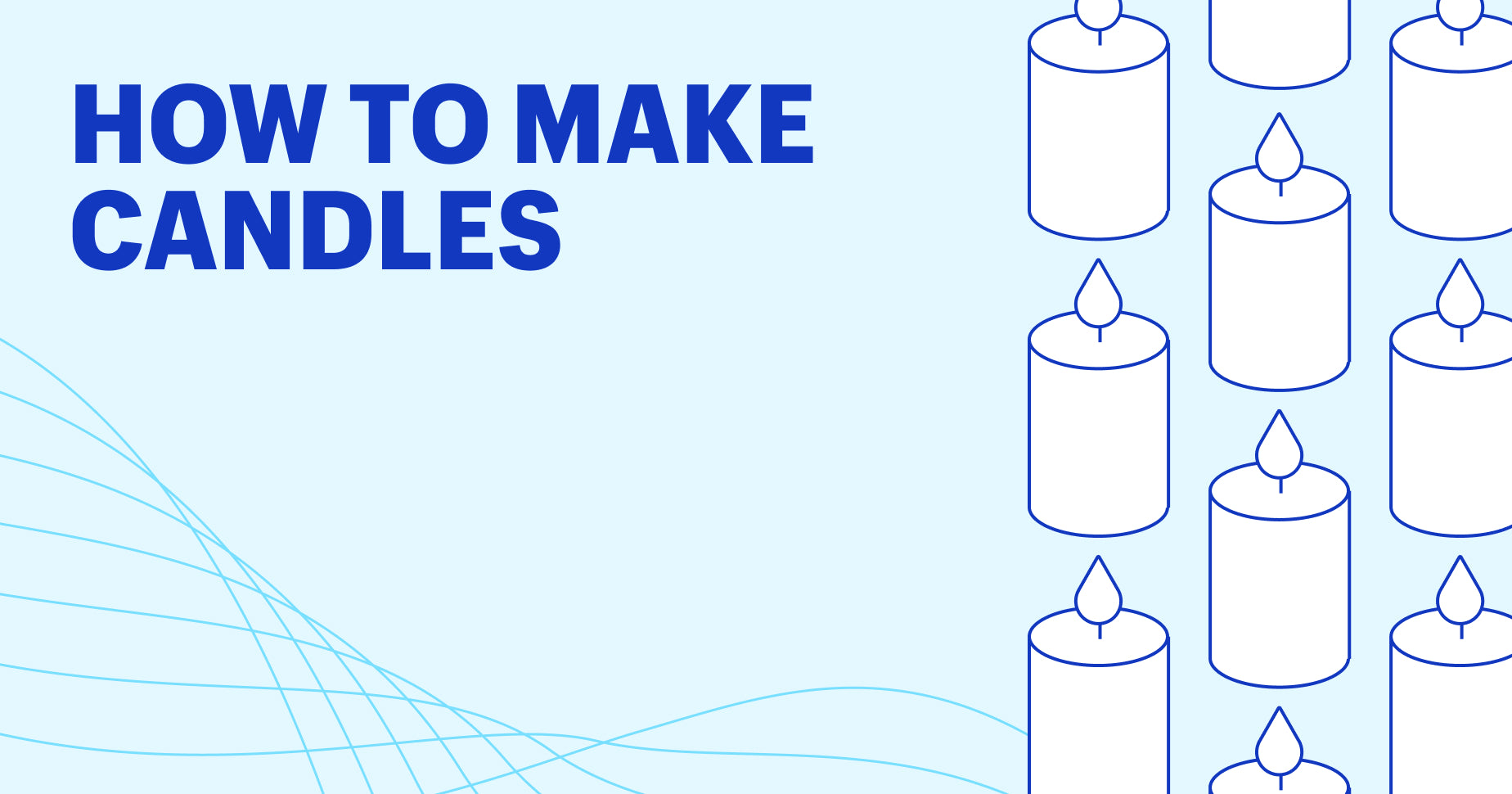Our view at Stack - Shopify has just about everything you need if you're looking to sell online. It excels with unlimited products, user-friendly setup, and 24/7 support. It offers 6,000+ app integrations, abandoned cart recovery, and shipping discounts up to 88%. Plus, it allows selling both online and in-person, scaling as your business grows.

If you’re starting your own candle-making business, figuring out what kind of candles to make and sell is one of the most fun parts of the job. There are many different fragrances, waxes, and accents (like pressed flowers) to choose from, and this process can take a lot of thought and creative energy.
But making candles at home can be fairly simple, as long as you plan carefully and use the right tools—and your candle-loving friends will appreciate your additions to their home décor.
Plus, this might just be the start of a side hustle or small business.
Ahead, learn what materials you will need and follow our 10-step guide on how to make candles.
Materials and tools needed to make candles
Here’s an overview of the supplies you’ll need to make homemade container candles.
Materials
Wax
Candle wax typically comes in wax shavings or wax flakes, which can be purchased in bulk online or from your local craft store.
Some of the most common types of wax used to make candles are:
- Paraffin wax
- Bees wax
- Soy wax
Wicks
Every candle needs a wick. Wicks are typically made of paper, cotton, zinc, or wood.
Thin wicks are appropriate for most candles, but can snuff out easily when used in large candles. Likewise, thick wicks tend to have larger flames, which melt wax quicker, making them a better choice for large candles.
Fragrance oils
Scented candles get their fragrance from essential oils or fragrance oils, which are added to the melted wax during the candle-making process.
You can use single-note fragrances, with one scent, pre-blended fragrance oils, or make your own combinations.
Here’s some scent inspiration:
- Single note:
bergamot, mandarin, or rosemary - Pre-blended: sea breeze, apple pie, or pumpkin spice
- Custom combinations: rose patchouli, lavender sage, to mint lime
The amount of fragrance oil and the type of wax you use will determine how much scent your candle gives off. Wax with a higher melting point, like bees wax will give off less scent than wax with a lower melting point, like paraffin.
Tools
Spatula
A heat-proof spatula for stirring wax will ensure an even melt.
Heat-proof candle containers
Mason jars, glass jars, or even tin cans make excellent candle containers. The larger the container, the larger your candle will be.
Double boiler
Double boilers are kitchen tools that evenly distribute stovetop heat for controlled warming—and they’re perfect for melting wax. You can use a store-bought double boiler or make one by placing a metal bowl on top of a pot with a small amount of water in the bottom.
Thermometer
Use a candy thermometer, a digital infrared thermometer, or a deep-fry thermometer to measure the temperature of your wax.
Popsicle sticks or pencils
To stabilize the wick during the curing process, you will need Popsicle sticks, pencils, chopsticks, or other lightweight, straight objects.
Paper towels
Don’t get wax on all of your kitchen towels! Paper towels are ideal for cleaning up wax drips.
How to make candles in 10 steps
- Prep containers and supplies
- Measure the wax
- Melt the wax
- Add your fragrances
- Place the wick
- Stabilize the wick
- Pour the wax
- Clean up
- Wait for the candle to cure
- Light your candle
Making candles at home requires a few specialized items, some planning, and a little bit of time—but it’s simpler than you might think. Here’s a step-by-step guide to the candle-making process.
1. Prep containers and supplies
You can purchase votive holders or specific candle jars from a craft store, but empty Mason jars or even tin cans will also work. Just make sure you like the look of the vessel—most poured candles cannot be transferred out of their container prior to burning.
Make sure that your candle containers are clean and dry, and place them on a flat surface. Keep your wicks, fragrance oils, and Popsicle sticks, chopsticks, or other wick holders nearby.
2. Measure the wax
Measure your wax by pouring wax flakes or wax shavings into your candle containers, which act as your candle molds. Because shavings take up more space than melted wax, use approximately two candle containers worth of flakes per candle.
3. Melt the wax
Pour your wax shavings or flakes into your double boiler and slowly warm the wax, using your spatula to carefully stir the melting wax and catch any bits that rise up the edges of the pot.
Paraffin wax melts at around 100 degrees Fahrenheit, soy wax melts at approximately 124 degrees Fahrenheit, and beeswax melts at around 145 degrees Fahrenheit. Use your candy thermometer to monitor the temperature.
4. Add your fragrances
If you are making scented candles, now is the time to get creative.
Some fragrance oils are specifically designed for candle making. For these, follow the instructions on the packaging. If you are using essential oils, add 30 to 40 drops of oil per eight ounce candle. Add the oils slowly and stir with your spatula.
5. Place the wick
Place one wick in each candle container. Seal the wick to the center bottom of the jar by placing a drop of wax (or a drop of Super Glue) on the bottom of the wick and letting it dry on the bottom of the jar. For an even burn, make sure the base of the wick is centered in the container.
6. Stabilize the wick
Before you pour the wax, place two Popsicle sticks across the top of the jar, sandwiching the wick between them. This will keep the wick upright as the wax hardens. You can also use chopsticks, pencils, or even butter knives—just be careful not to drip too much wax on them in the process.
7. Pour the wax
Carefully pour the wax, filling the candle container to just below the top of the rim. Pour slowly to minimize air bubbles.
8. Clean up
Dried wax can be tricky to clean up. Wipe up any melted wax drips on your work surface or the outside of the candle mold with paper towels. Hot water can be used to clean up hardened wax spills.
9. Wait for your candle to cure
Soy candles will harden to room temperature in about four hours and completely cure in three to four days. Paraffin wax candles cure faster (in about two days), and beeswax candles take up to 10 days to cure completely. Once the candle is dry, you can remove the chopsticks and trim your wick.
If your candle has dried with pockmarks or indentations in the surface—typically caused by air bubbles rising during the drying process—warm a little bit more wax and add a thin layer on top.
10. Light your candle
Light ’em up and let ’em burn! Candles make great gifts or online store items, and are a cost-effective way to achieve a beautifully lit, aromatherapy-infused home.
Learn more: How To Start a Candle Business in 2024
How to make candles FAQ
How do you make homemade candles?
Candle-making requires three key steps:
1. Melt your wax.
2. Pour it in a jar with a wick.
3. Let it set.
You can also get creative with scented oils, colorful layers, or decorative add-ins.
What ingredients do you need to make a candle?
All candles require three items:
1. Wax
2. A candle mold or container
3. A wick
Tools like a double boiler, Popsicle sticks, and candy thermometer also come in handy.
Is it cheaper to make your own candles?
Yes. While fancy scented candles can cost over $100 for an eight ounce pour, a pound of soy wax flakes (enough for three, eight ounce candles) can cost between $2 and $10. Many fragrance oils also retail for under $10.
How do I make my candles smell stronger?
The secret to powerfully scented candles is the oil. If essential oils aren’t producing the scent you’re looking for, try a specially formatted fragrance oil. These are made specifically for candles and are designed to project a stronger scent when burned. The type of wax you use will also impact the strength of your scent. Wax with a high melt point will give off less scent than wax with a low melting point.
If Shopify is of interest and you'd like more information, please do make contact or take a look in more detail here.
Credit: Original article published here.
